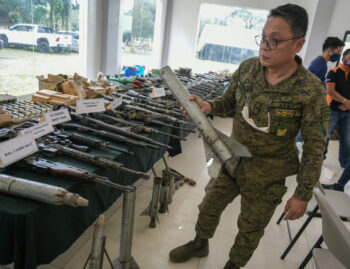MALAYBALAY CITY (MindaNews / 29 April) – President Barack Obama’s state visit to the Philippines and other Asian countries, seen as a move to consolidate US hold on affairs in the region, has again sparked debates on the long-term wisdom of hosting US troops in the country in the context of Chinese aggression in the West Philippine Sea.
Defense officials and others who favor stronger US military presence in this part of Asia through the Enhanced Defense Cooperation Agreement see it as an effective deterrent to the threat posed by China. (It does not seem to matter that the Obama administration has always issued nuanced statements when it comes to US-China relations. It has given no categorical statement that the US would help the Philippines in a war with China.)
Others view the signing of the agreement as something that would only increase China’s resentment, which seems to have reached tipping point after the Philippines went on to submit her claim on parts of the Spratly Islands to international arbitration. However one sees it, EDCA categorically aligns the Philippines with US geopolitical and economic interests, endangering relations with her strongest neighbor.
But for now let’s postpone the cost-benefit debate on EDCA and revisit how US troops have managed to return 10 years after the Jovito Salonga-led Philippine Senate voted to kick them out.
‘Permanent visit’
In May 1999, US troops slipped back into the archipelago, mainly in Mindanao, through the Visiting Forces Agreement. There are actually two VFAs, although only VFA-1 was submitted to the Senate for ratification. Since VFA-2 contains a provision for supplementary agreements, it stands on shaky legal grounds, as Senate concurrence to VFA-1 bars the president from unilaterally binding the country to amendments of the treaty.
But legal questions aside, events since the re-entry of US troops in 2002, purportedly for training and joint military exercises, have shown that their presence is anything but temporary. It is more like a permanent visit, clearly a contradiction in terms. The title of the treaty – treaty from the viewpoint of the Philippines but considered a mere executive agreement by the US – simply seeks to go around the constitutional ban on permanent foreign military bases in the country.
In 2005, former US Ambassador to the Philippines Francis Ricciardone described such “visits” as “semi-continuous, not permanent, but semi-continuous (military presence), that is to say, some number of our personnel rotate at the pleasure of the command, your command.”
For all intents and purposes though, the US has reestablished permanent presence in the Philippines. US troops are no longer in places like Clark and Subic because the constitution prohibits that. What they have done is co-locate in Philippine military camps. For example, Camp Navarro in Zamboanga City hosts an American installation guarded by US Marines and which is off limits to Filipino military officials.
US and Philippine authorities may say that Camp Navarro remains a Filipino military installation, and the presence of US troops and facilities there should not be considered a violation of the constitution much less a diminution of national sovereignty. Indeed, a clever way to skirt Article 18, Section 25 of the constitution which states: “Foreign military bases, troops, or facilities shall not be allowed in the Philippines, except under a treaty duly concurred in by the Senate…”
The same deceptive manner can be used by the US in establishing permanent presence in any part of the Philippines. And the country’s ever subservient foreign policy leaves no doubt the Americans are here to stay for as long as they want.
(MindaViews is the opinion section of MindaNews. H. Marcos C. Mordeno can be reached at hmcmordeno@gmail.com.)







